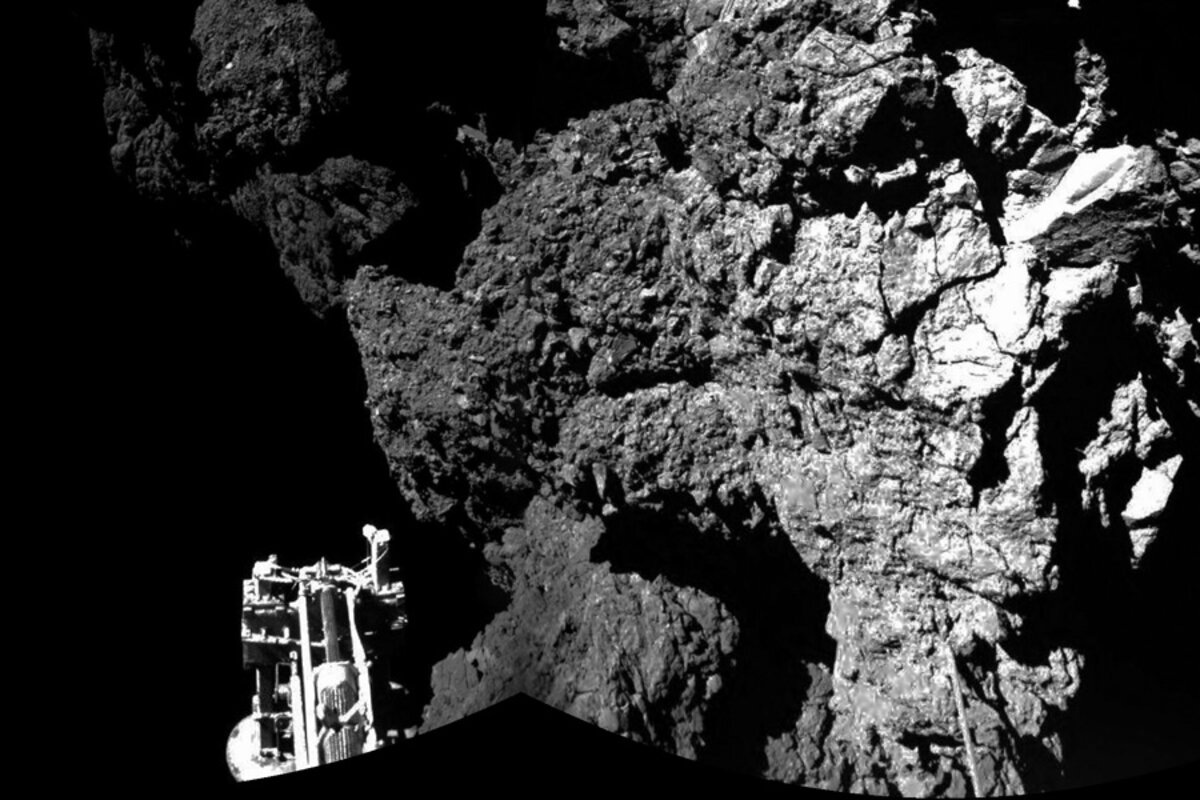What did Philae learn in its first 57 hours on the comet?
Loading...
For 57 hours in mid November, a squat lander with spindly legs made history as the first spacecraft to visit the nucleus of a comet – sending a wealth of information on the object to solar-system scientists back on Earth.Мэ
Q:МэWhy visit comets?
Comets represent windows on the dawn of the solar system. By studying the composition of the dust and ice that comprise them, they hold the potential to reveal information about the basic ingredients that birthed the solar system’s planets. Comets are also thought to have delivered water and a range of organic chemicals to a young Earth, setting the stage for organic life to evolve. Мэ
Q:МэWhat was significant about the Rosetta mission?
Prior to the Rosetta mission, eight spacecraft visited seven comets between 1985 and 2011. But they all were blink-and-you’ll-miss-it flybys. NASA’s Stardust mission captured samples of dust from the extended halo around comet Wild 2 in 2004. In 2005, NASA’s Deep Impact mission released a projectile that punched a crater into the nucleus comet Tempel 1. The material ejected yielded information about the composition of the comet’s interior.Мэ
The European Space agency’s $1.7-billion Rosetta mission, including its lander Philae, aimed to take a deeper, more detailed look at the composition and structure of a a comet’s core to help test the idea that they serve as a kind of time capsule rather than a jumble of heavily altered rock, dust, and ice. In addition to learning about the comet’s anatomy, it would help test the idea that they serve as a kind of time capsule rather than a jumble of heavily altered rock, dust, and ice.Мэ
On Aug. 6 the Rosetta mission arrived at comet 67P/Churyumov–Gerasimenko, which belongs to the Jupiter family of comets – objects thought to have formed far beyond the orbit of Neptune but whose orbits are now heavily influenced by Jupiter’s gravity. The mission will continue to orbit the nucleus, making a range of measurements in its dust and gas as the comet makes its closest approach to the sun on Aug. 13, 2015.Мэ
Q:МэWhat did Philae find?
The lander’s science team is still analyzing the data Philae sent back from its nine instruments. But the Nov. 12 landing yielded an unexpected insight when the lander’s anchoring system failed to deploy and it bounced twice through comet’s weak gravity – once with a hang time of just under two hours.Мэ
The bounces suggested that the nucleus has an unexpectedly stout crust beneath a layer of dust. Indeed, the science team now reports that the comet appears to have a crust of rock-solid ice beneath a four- to eight-inch layer of dust. Instruments also detected organic molecules, although researchers are still working to identify them.
In addition, researches say an experiment to build a 3-D image of the core’s interior successfully gathered all of the data needed to build the image – critical to understanding how the comet formed.
Q:МэIs there a chance to hear from Philae again?
“I’m very confident that Philae will resume contact with us and that we will be able to operate the instruments again,” says Stephan Ulamec, the lander’s project manager.
The lander came to rest on patch of the comet heavily shaded by nearby rock formations, which shielded Philae’s solar arrays preventing it from recharging its batteries. After 57 hours of data-gathering, Philae fell silent. But just before Philae shut down its experiments and communications systems, controllers managed to rotate the lander’s body so that the largest set of solar cells on its sides aimed toward the available sunlight. Mission planners expect that as the comet nears the sun, Philae’s battery can recharge enough to restore its communication with the orbiting Rosetta and reactivate its instruments.
The shady spot may be a benefit, Dr. Ulamec explains. The shade could keep the lander cool as the comet approaches the sun, while still allowing enough light to reach the lander’s solar cells to recharge its main battery.
Q:МэAre other robotic missions to comets or asteroids coming up?
On Nov. 30, Japan is scheduled to launch its Hayabusa 2 mission, which aims to orbit asteroid (162173) JU3 starting in June 2018. The mission is slated to return samples of the asteroid to Earth in December 2020.Мэ
In 2016, NASA also is launching an asteroid-sample return mission, OSIRIS-Rex. If all goes well, the orbiter will reach asteroid 1999 RQ36, orbit it for six months to map the surface, then dip down to scoop a two-ounce sample for return to Earth in 2023. Each asteroid has a different composition. The asteroid NASA aims to reach is thought to be among the most primitive, hosting water-rich clay minerals, organics, and simple forms of sulfur.Мэ





